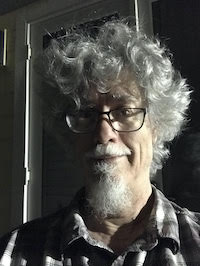Most of these poems are dramatic monologues. The hobo, the hermit, the gypsy speak to us in first person.
If you want to know about a society, examine its criminals, its scapegoats, its hermits, and its hobos. Look to people without privilege to see what privileges protect. If you are interested in the goodness of human kind and how to promote it, don’t ask questions of the slave owner, but of the slave, not because the slave is necessarily a better person, but because the slave has less means and fewer reasons to hide the truth.
My great grandmother, Barbara Ellen Leffler, was an albino in the circus. Her husband, my great grandfather, William Newton Sharp, was a tent man and a barker.
Matsuo Bashō left Edo (Tokyo) in 1684 on the first of four major wanderings. He traveled alone and on foot. On this first trip, he walked to Mount Fuji, Ueno, and Kyoto. On his trip over the narrow road to the deep north, he traveled with his disciple Kawai Sora, leaving in May 1689 and returning in late 1691.
My sources, in addition to wikipedia.org, are Hojoki: Life in a ten-foot square hut by Kamo-no Chōmei, 1212, Oku no Hosomichi: The Narrow Road to the Deep North by Matsuo Bashō 1702, and Walden; or Life in the Woods by Henry David Thoreau, 1854.
The photo on the cover is from the Library of Congress. It shows two hobos walking along railroad tracks. The man in the foreground is carrying a bindle.
In any page, you can click on or touch links to jump around in this book.
You may find the following keyboard equivalents to be convenient. Here I use the symbol ⌥ for the option key on Mac/OS or the alt key on Windows, ⇧ for the shift key, and ⏎ for the return (enter) key. Arrow keys are ◄ (left), ► (right), ▲ (up), and ▼ (down).
| Context | Keys | Jump to / Behavior |
|---|---|---|
| cover | ⌥ ◄ | Books by Tom Sharp |
| ⌥ ▲ | About Tom Sharp | |
| ⌥ ► | about this book (this page) | |
| ⌥ ▼ | contents | |
| ⇧ ⌥ ▼ | contents | |
| contents | ⇧ ⌥ ▲ | cover |
| ⌥ ▼ | select the next item in the contents | |
| ⌥ ▲ | select the previous item in the contents | |
| ⌥ ► | open the selected page | |
| ⌥ ⏎ | open the selected page | |
| poem | ⇧ ⌥ ▲ | contents |
| ⌥ ◄ | contents | |
| ⌥ ▲ | select the previous poem, or, from the top poem, open the previous page | |
| ⌥ ▼ | select the next poem, or, from the bottom poem, open the next page |

Tom Sharp is a Native American of Aleut heritage, a member of Seldovia Village Tribe. He is the author of numerous books, including Spectacles: A Sampler of Poems and Prose, Taurean Horn Press (ISBN 0-931552-10-9), a novel, Hans and the Clock (ISBN 979-8580172484), The book of science, SciFi (ISBN 979-8694935210), Things People Do (ISBN 979-8687425568), The book of beliefs (ISBN 979-8683553593), The I Ching (ISBN 979-8573510620), Images (ISBN 979-8577560515), Aleut Artifacts (ISBN 979-8575608998), Aleut Words (ISBN 979-8582103394), and First Nations (ISBN 979-8682924769).
